Embark on a journey into the world of Sasso chicken farming in India! Discover the untapped potential and benefits of raising these exceptional birds. From robust health to superior meat quality, Sasso chickens are a game-changer for Indian poultry enthusiasts. Join us as we unravel the secrets to successful Sasso chicken farming, providing insights into their unique traits and promising opportunities.
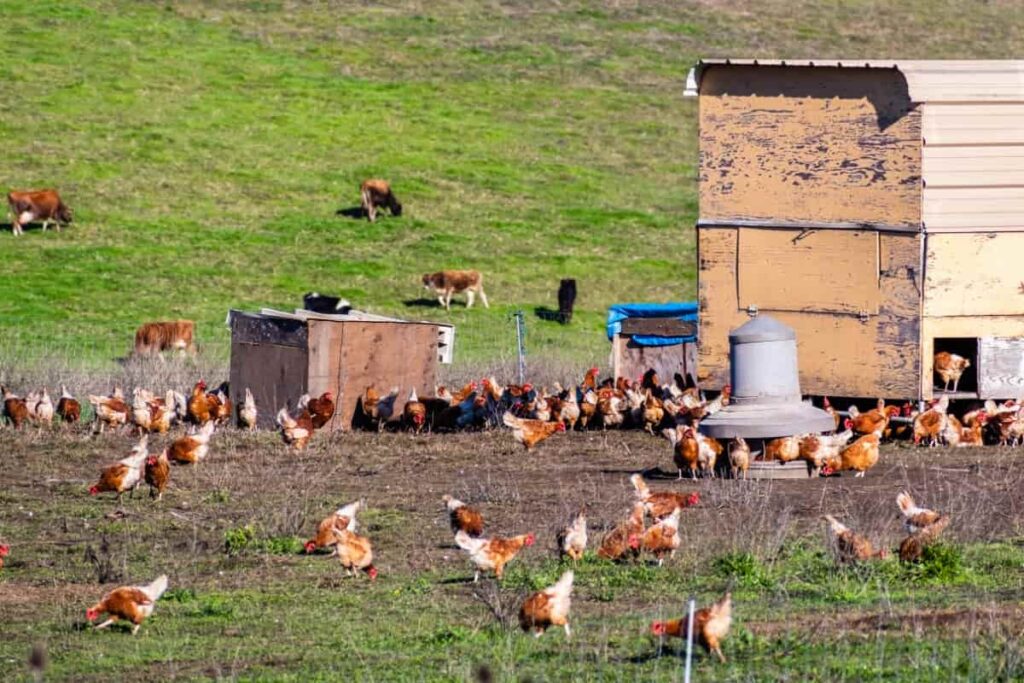
Sasso Chicken Farming
Sasso Chicken Farming in India
Sasso chicken farming in India introduces a breed renowned for its exceptional characteristics. Sasso chickens from France embody robust health, adaptability, and efficient growth. These birds are prized for their high-quality, flavorful meat and superior feed conversion rates. Sasso chickens exhibit natural foraging behavior, reducing the reliance on artificial feeds.
Their distinctive traits include vibrant plumage, strong immunity, and a calm demeanor, making them well-suited for diverse farming environments in India. The Sasso breed’s ability to thrive in free-range systems aligns with sustainable and ethical farming practices. Small-scale farmers find Sasso chicken farming appealing due to its low input requirements and the assurance of a premium product.
History and Origin of Sasso Chickens
Sasso chickens are not a new breed. They have been around since the 1970s when they were developed by a French company called SASSO (Selection Avicole de la Sarthe et du Sud Ouest). The company wanted to create a breed that could meet the demand for traditional poultry products in France and other countries. They crossed local breeds with imported breeds, such as Rhode Island Red, Sussex, and Plymouth Rock, to produce different colors and patterns. The result was a breed with the flavor and texture of country chicken but improved performance and adaptability.
Advantages of Sasso Chicken Farming in India
- High meat quality: Sasso chickens have tender, juicy, and flavorful meat that many consumers prefer.
- Their meat is also leaner and healthier than conventional broilers.
- Rapid growth: Sasso chickens grow faster than native breeds, reaching market weight in about 12 weeks.
- This means you can sell them sooner and earn more profits.
- Climate adaptability: Sasso chickens can survive in different climatic conditions, from humid and hot to cold and dry.
- They can also tolerate high altitudes and low oxygen levels.
- Resistance to diseases: Sasso chickens have strong immunity and can resist common poultry diseases like Newcastle, Gumboro, and Marek’s.
- They also have fewer parasites and worms than native breeds.
- Easy management: Sasso chickens are easy to manage and require minimal input.
- They can be raised on free-range, semi-intensive, or intensive systems.
- They can also consume a variety of feeds, including farm byproducts and kitchen scraps.
In case you missed it: 18 Best Egg Laying Chickens: Foods that Increase Egg Production, Egg Laying Frequency, and Egg Laying Chart
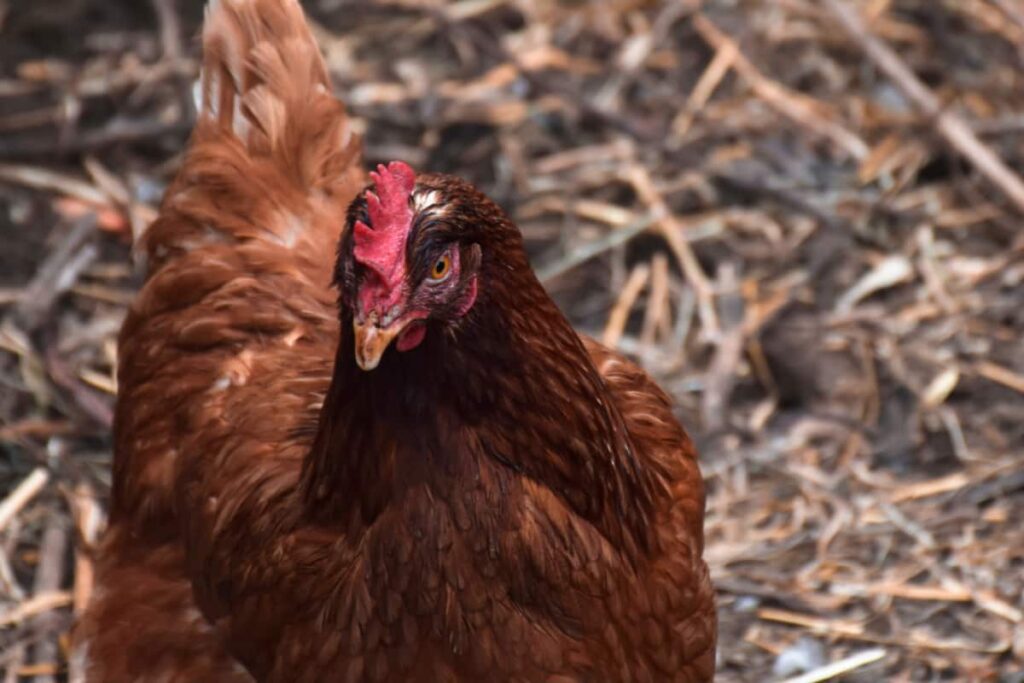
Suitable Climate and Environment for Sasso Chicken Farming
Sasso chickens can thrive in various climates and environments in India, but they require specific conditions for growth and health. To ensure a suitable environment, choose a well-drained, well-ventilated location, provide adequate shade and shelter, maintain a temperature range of 16°C to 30°C, ensure clean water, and keep litter dry and clean to prevent diseases and odors. Use materials like rice husk, sawdust, or straw as bedding to ensure a healthy and comfortable environment for your chickens.
Housing and Infrastructure Requirements for Sasso Chicken Farming
The type of housing and infrastructure needed for a Sasso chicken farm depends on the chosen system. Free range is the simplest and cheapest option, allowing chickens to roam freely in a large area. A spacious, secure, well-ventilated bamboo, wood, or metal shelter is necessary. Fencing is also necessary to prevent predators from wandering off. Semi-intensive is confined to a smaller area during the day and released in the evening, providing a shelter with feeders, waterers, nests, perches, and litter.
The shelter should be large enough to accommodate all chickens comfortably and made of materials like wire mesh or netting. Fencing is also necessary to protect the area from predators and thieves. Intensive is the most expensive, requiring chickens to be kept indoors in cages or pens with well-ventilated, well-lit shelters. Materials like concrete, brick, or metal can be used, and fans, heaters, or coolers can be installed to regulate temperature and humidity.
Feeding and Nutrition Management for Sasso Chickens
Sasso chickens, a French broiler breed, are known for their robustness, adaptability, and meat quality. They can be reared under various production systems and utilize various feed resources, including farm by-products and scavenging. Sasso chickens have a slower growth rate than conventional broilers but produce firm, flavorful meat that commands higher market prices. To unlock the potential of Sasso chickens, farmers need to adopt proper feeding and nutrition management practices that suit their production system and available feed resources.
To ensure optimal results, farmers should always provide adequate and clean water, as it is essential for digestion, metabolism, temperature regulation, and egg production. Good quality feed that meets the nutrient requirements of Sasso chickens is crucial, as it affects feed intake, nutrient utilization, growth rate, feed conversion ratio, carcass quality, and immune response.
Factoring balanced rations that match the production system and feed resources is essential for Sasso chickens. Commercial feeds are convenient and standardized but expensive and scarce in some areas. Home-made rations are cheaper and more adaptable but require careful formulation and mixing to ensure adequate nutrient supply. Farmers can use feed formulation software or consult extension agents or nutritionists to help formulate balanced rations for Sasso chickens.
In case you missed it: 15 Best Heritage Breed Chickens for Meat, Eggs and Dual-Purpose
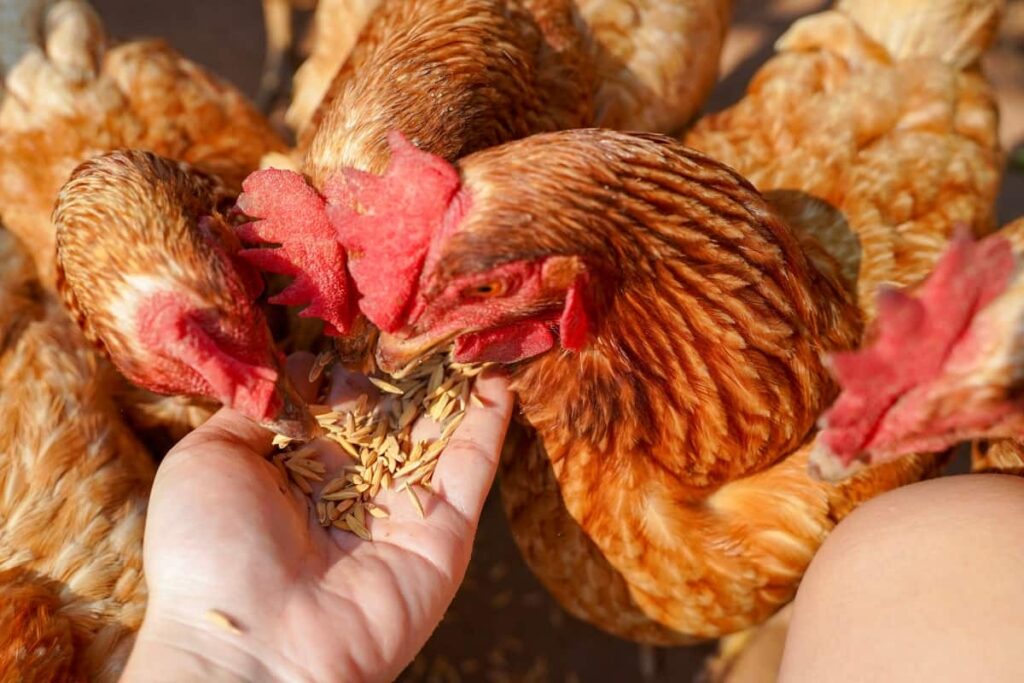
Adjusting the feeding frequency, method, and amount according to the production system and bird performance is also important. Ad libitum feeding can result in faster growth and higher feed intake, while restricted feeding can lead to slow growth and lower feed intake. Supplementing the diet with vitamins, minerals, enzymes, probiotics, or other additives can enhance Sasso chickens’ nutrient absorption, digestion, metabolism, immunity, or performance.
Health and Disease Management in Sasso Chicken Farming
Sasso chickens are susceptible to various diseases and parasites impacting their health and productivity. Common diseases include Newcastle disease, which causes respiratory signs, nervous signs, and high mortality, and Infectious bursal disease (IBD), which affects the immune system of young birds and increases susceptibility to other infections. Coccidiosis, a parasitic disease affecting on intestinal tract, causes bloody diarrhea, weight loss, and mortality.
External parasites like lice, mites, fleas, and ticks infest birds’ skin and feathers, causing irritation, itching, feather loss, and reduced growth. Farmers should keep birds in clean and dry housing to prevent these, use insecticides or natural repellents, and regularly check for infestations. Internal parasites, such as worms in the digestive system, cause poor feed utilization, weight loss, anemia, and mortality. Dewing birds every three months with suitable anthelmintics or natural remedies can help prevent these parasites.
To ensure good health and disease management in Sasso chicken farming, farmers should provide clean and fresh water and feed at all times, maintain good hygiene and sanitation in the poultry house and equipment, observe birds daily for signs of illness or abnormality, isolate sick or injured birds for treatment or culling, keep records of vaccination, deworming, medication, mortality, and production, and seek advice from a veterinarian or extension officer if any disease outbreak occurs or unusual symptoms are observed.
Breeding and Reproduction Techniques for Sasso Chickens
- Sasso chickens are slow-growing colored broilers with high fertility and hatchability rates.
- Depending on the farmer’s preference and resources, they can be bred naturally or artificially.
- Natural breeding involves keeping a ratio of one male to 10 females in a flock and allowing them to mate freely.
- Artificial insemination (AI) involves collecting semen from selected males and injecting it into the oviducts of selected females.
- Incubation can be done naturally using broody hens or artificially using an incubator.
- Natural incubation involves using broody hens to hatch the eggs under their feathers.
- Broody hens should be healthy, calm, attentive to their eggs, and provided with a separate nest box with clean bedding materials.
- Artificial incubation involves using an incubator to hatch the eggs under controlled temperature and humidity.
- The incubator should be clean, well-ventilated, and free from contaminants.
- Eggs should be placed in the incubator with the pointed end down and turned thrice daily.
- The temperature and humidity should be maintained at specific levels throughout the incubation period.
- Eggs should be candled at specific intervals to check for fertility and viability.
- Eggs should hatch after 21 days of incubation through natural or artificial methods.
Market Potential and Economic Viability of Sasso Chicken Farming in India
Sasso chicken farming is a profitable and sustainable business that offers income and food security to rural farmers in India. Sasso chickens are hardy, adaptable, and easily managed under various production systems and climatic conditions. They can survive on low-quality feed, scavenge for food, and resist common diseases and parasites.
Sasso chickens have high fertility and hatchability rates, ensuring a steady supply of chicks for replacement or sale. They have a slow growth rate, resulting in firm, flavorful meat with less fat and more protein. Their attractive multi-colored feathers appeal to consumers’ preference for traditional country chicken. Sasso chickens have high market demand and price due to their superior meat quality, taste, and appearance.
In case you missed it: Chicken Farming in India: Poultry Farming Cost, License, and Requirements to Start in India
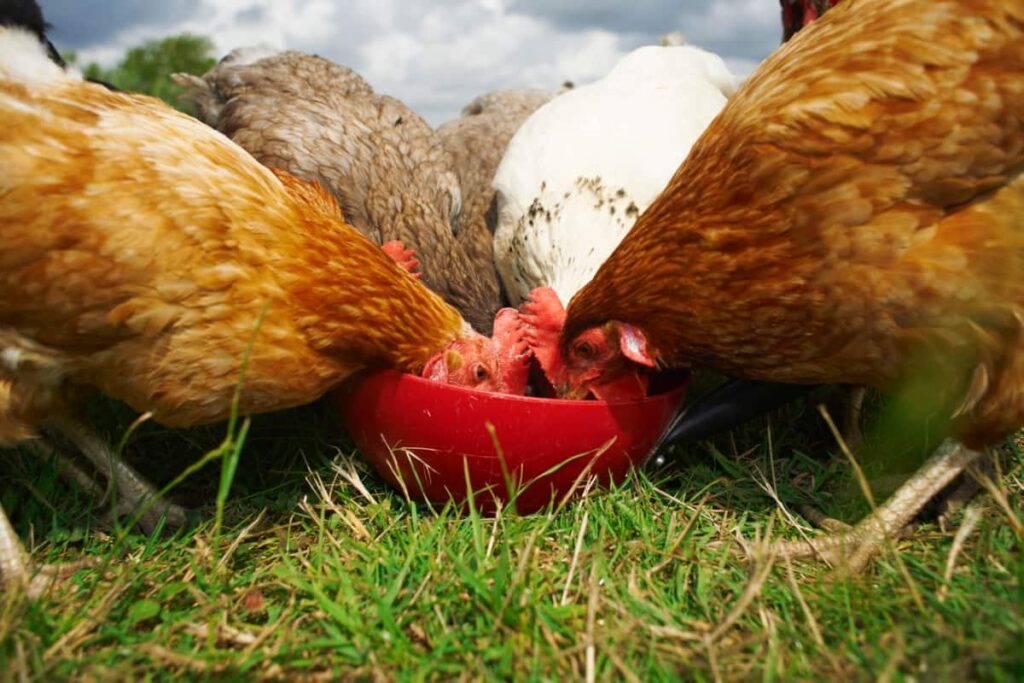
A study by Singh et al. (2020) found that Sasso chicken farming in India has a high economic viability with a benefit-cost ratio of 1.64 and an internal rate of return of 38%. The study also found that Sasso chicken farming positively impacts rural farmers’ income, employment, and nutritional security, especially women and youth.
Challenges and Risks Associated with Sasso Chicken Farming
Sasso chicken farming faces several challenges and risks that can impact its productivity and profitability. Predation, particularly from predators like dogs and cats, can lead to the loss of birds, eggs, or chicks, reducing farmers’ flock size and income. Thieves, attracted by the high market value and demand, can steal these chickens from the farm or during transportation to the market. Common poultry diseases like Newcastle disease, IBD, and coccidiosis can also affect the health of birds or chicks, reducing production and income.
Market fluctuations, influenced by supply and demand changes, seasonality, competition, and consumer preferences, can also affect the price and profitability of Sasso chicken farming. To mitigate these risks, farmers should implement measures such as providing adequate protection from predators, securing the farm from thieves, preventing or controlling disease outbreaks, and monitoring market trends to adjust production accordingly.
Government Policies and Support for Sasso Chicken Farming in India
India’s government has recognized the potential of Sasso chicken farming for rural development and poverty alleviation. To support this, the government has implemented policies and programs such as the National Livestock Mission (NLM), which provides financial assistance for breeding, healthcare, feed and fodder development, infrastructure development, and skill development. Farmers can also avail subsidies for purchasing improved poultry breeds like Sasso chickens. The Rashtriya Krishi Vikas Yojana (RKVY) aims to enhance agricultural productivity and income.
Comparison of Sasso Chickens with Other Poultry Breeds in India
| Characteristic | Sasso | Cobb | Vanaraja | Aseel | Broiler |
| Growth Rate | Moderate | Fast | Moderate | Slow | Very Fast |
| Meat Quality | Excellent | Good | Good | Good | Excellent |
| Adaptability to Free Range | High | Moderate | High | Low | Low |
| Feed Conversion Efficiency | Efficient | High | Moderate | Low | Very High |
| Foraging Behavior | Natural | Limited | Natural | Limited | Limited |
| Immunity | Strong | Moderate | Strong | Moderate | Moderate |
| Plumage Color | Varied | White | Varied | Varied | White |
In case you missed it: 15 Best Electric Chicken Debeaking Machines: Price List Included
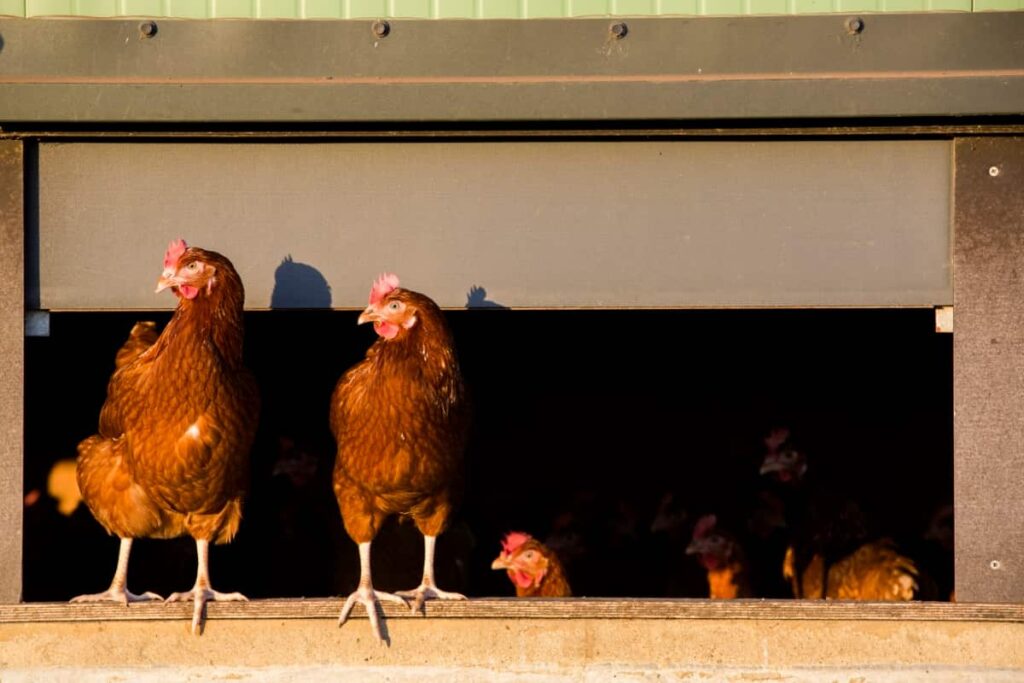
Frequently Asked Questions (FAQs) on Sasso Chicken Farming in India
How Long Does It Take for Sasso Chickens to Reach Market Weight?
Sasso chickens typically attain market weight in approximately 12 to 14 weeks.
Are Sasso Chickens Suitable for Free-Range Farming?
Yes, Sasso chickens exhibit excellent adaptability to free-range farming systems.
What is the Average Feed Conversion Ratio for Sasso Chickens?
The average feed conversion ratio for Sasso chickens hovers around 2:1.
Can Sasso Chickens Be Reared Alongside Other Poultry Breeds?
Sasso chickens can be comfortably raised alongside other poultry breeds without significant issues.
How Do I Ensure Biosecurity in My Sasso Chicken Farm?
To maintain biosecurity, implement stringent measures such as controlled access, regular disinfection, and isolation of new birds. These practices minimize the risk of diseases and contribute to a healthy Sasso chicken farming environment.
In case you missed it: Easter Egger Chicken Breed: Origin, Price, Characteristics, Egg Production, Appearance, and Care
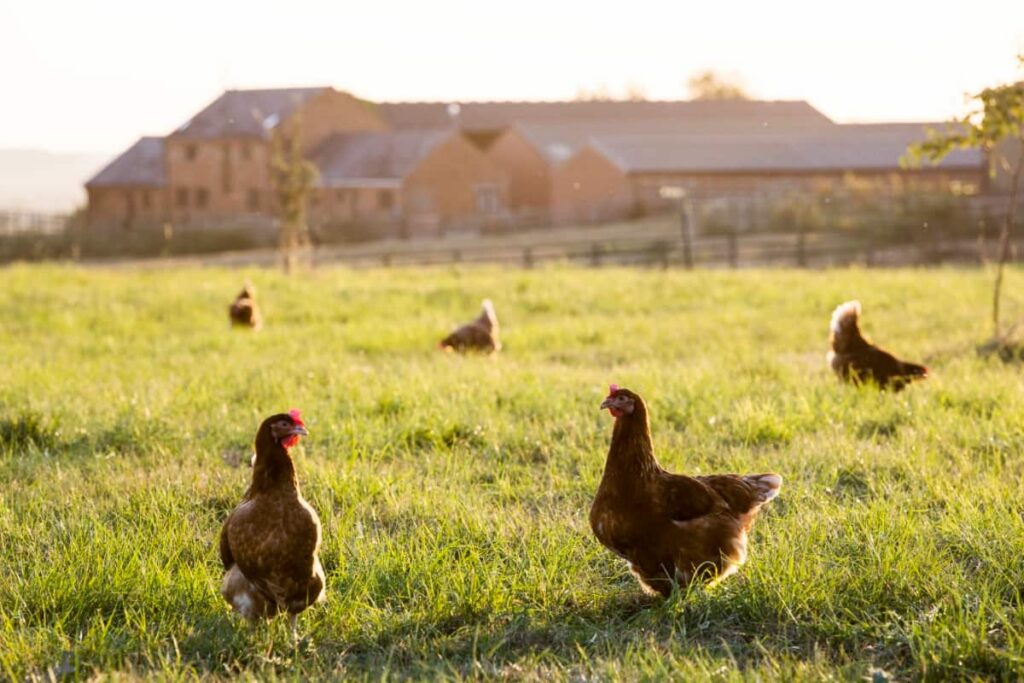
Conclusion
Sasso chicken farming in India unveils a world of possibilities. With their robust health, flavorful meat, and adaptability, Sasso chickens offer a promising venture for poultry enthusiasts. Unlock the potential of sustainable and rewarding farming.
- Broccoli Varieties: Choosing the Right Cultivars for Your Farm
- How to Raise Pigs in Your Own Backyard: A Comprehensive Guide
- Budget Friendly Sheep Shed Ideas: Cheap and Low-Cost Tips
- How Much Do Cattle Farmers Make: Revenue Streams in Cattle Farming
- Management Pests and Diseases in Your Cotton Field
- Sheep Farming Business Plan for Beginners
- Aquaponic Farming at Home: A Step-By-Step Guide
- Profitable Village Farming Business Ideas in 2024
- High-Yield Aquaculture: Fast-Growing Fish for Farming
- Effective Fish Pond Construction Techniques for Beginners
- Irrigation and Water Management in Pineapple Farming
- Blossom to Harvest: Mastering Flowering and Pollination in Papaya Farming
- Pig Fattening Essentials: From Selection to Sale for Beginners
- Raising Wagyu Cattle: A Complete Guide for Premium Beef Production
- Soil Types and Their Water Holding Capacity
- Optimizing Irrigation Schedules for Coconut Groves for Enhanced Yield
- Espresso Your Garden: Coffee Grounds for Healthier Acid-Loving Plants
- The Best Soil Mix for Snake Plants: How to Mix Your Own Snake Plant Soil
- Green Thumb Success: Expert Tips for Cultivating Greenhouse Beans All Year Round
- Bloom All Year Round: The Ultimate Guide to Indoor Hyacinth Care
- Eco-Friendly Gardening: How to Make Liquid Fertilizer from Kitchen Waste
- Ultimate Guide to Grow Anise in Pots: Explore Seed Propagation to Harvesting
- Guide to Raising Chester White Pigs: Discover Breed Facts to Growth Management
- Mastering the Elegance: The Ultimate Guide to Weeping Cherry Tree Care, Planting, and Maintenance
- Ultimate Guide to Planting Garlic in Grow Bags: Growing Strategies for Beginners
- How to Fix Spider Plant Leaf-Related Problems: Natural and Organic Remedies
- 10 Reasons Why Your Tulsi Plant is Shedding Leaves: Home Remedies and Solutions
- Optimizing Growth and Yield: The Advantages of Palm Bunch Ash Fertilizer
- Utilizing Neem Oil Extract as a Natural Pesticide for Hydrangea
- From Soil to Harvest: Various Ways in Which Farmers Can Use AI Tools
- Steps to Encourage and Induce Citrus Flowers: A Comprehensive Guide
- How to Fix Snake Plant Leaf-Related Issues: Natural and Organic Remedies
- Transform Your Garden into a Fragrant Oasis with Raat Ki Rani (Night Blooming Jasmine)
- Discover the Ideal Chicken Breeds for Philippine Farms
- How to Create a Poultry Egg Farm Business Plan for Profits
- Grow Lemon Cucumbers Like a Pro: Insider Techniques for Bountiful Yields
